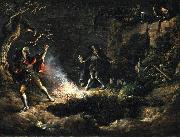Wholesale Oil Painting Reproductions No Minimum and Door to Door! |
|||||||||||
|
|
|||||||||||

|
|||||||||||
|
|
|
||||||||
All John Quidor Oil Paintings |
||||||||
|
|
||||||||
|
|
||||||||
|
Artist Introduction: 1801-1888
Quidor was born in Gloucester Co., N. J., and in 1826 moved to New York City where he studied painting under John Wesley Jarvis and Henry Inman. Afterward he lived on a farm near Quincy, Illinois, but returned to New York City in 1851. He was obliged to support himself by painting the panels of stage coaches and fire engines and died in abject poverty.
Although Quidor was little appreciated in his own time, after his death he was accorded a place among the best early American artists. His paintings establish a mysterious romantic setting for scenes in which he mingled macabre elements with an earthy humor. Many of his works, such as Ichabod Crane Pursued by the Headless Horseman, in the Smithsonian American Art Museum, were inspired by the writings of Washington Irving, who was a personal friend. Irving's A History of New York gave Quidor the subjects for the four paintings in the Brooklyn (N. Y.) Institute: Dancing on the Battery (c. 1860), Peter Stuyvesant's Wall Street Gate (1864), Voyage of the Good Oloff up the Hudson (1866), and The Voyage from Communipaw to Hell Gate (1866). These show Quidor's characteristic mellow and harmonious color, poetic imagination, and naïve humor.
He is represented in the Brooklyn Museum by three paintings: Dorothea, Money Diggers, and Wolfert's Will. He also painted religious subjects such as Jesus Blessing the Sick. |
||||||||
|
|
||||||||
|
Money Diggers Painting ID:: 72734 |
Date ca. 1832(1832)
Medium Oil on canvas
Dimensions 40.5 X 53.2 cm (15.94 X 20.94 in)
cyf |
|||||||
Height Width |
INS/CM Quality |
|||||||
|
CONTACT US |

